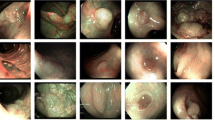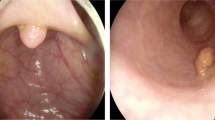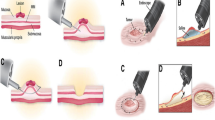Abstract
Colorectal cancer (CRC) is caused by malignant polyps which must be resected and examined for accurate classification. Biopsy, the manual workflow of polyp classification is time-intensive task and requires an automated solution. The objective of this study is to develop an accurate virtual biopsy tool for polyp classification. Moreover, automated assessment of polyps is a challenging task due to the similarities in their patterns, and in contrast to existing studies on binary classification, the outcome of multi-class classification requires evaluation through advanced evaluation measures. The proposed method combined the strength of individual weak learner for an accurate weighted-average ensemble deep learning classification. At first, base-classifiers were pretrained on the ImageNet database. Second, an average ensemble was built and evaluated for enhancing the performance, an appropriate combination of weights was chosen through grid search and assigned to the models. The performance evaluation of the proposed method in terms of F1-micro (0.80), F1-macro (0.81), F1-weighted (0.84) metrics, model reliability using Cohen’s Kappa Coefficient (0.60) and Mathew Correlation Co-efficient value (0.49) for binary dataset shows the superiority over existing models. The higher rates of precision and recall show potential usage of the proposed system in the development of a virtual biopsy tool.










Similar content being viewed by others
Explore related subjects
Discover the latest articles, news and stories from top researchers in related subjects.References
Chan HP, Samala RK, Hadjiiski LM, Zhou C (2020) Deep learning in medical image analysis. In: Lee G, Fujita H (eds) Deep Learning in Medical Image Analysis. Advances in Experimental Medicine and Biology, vol 1213. Springer, Cham. https://doi.org/10.1007/978-3-030-33128-3.1
Chen-Ming H, Chien-Chang H, Zhe-Ming H, Feng-Yu S, Meng-Lin C, Tsung-Hsing C (2021) Colorectal polyp image detection and classification through grayscale images and deep learning. Sensors 21(18):5995
Corley DA, Jensen CD, Marks AR, Zhao WK, Lee JK, Doubeni CA, Zauber AG, de Boer J, Fireman BH, Schottinger JE, Quinn VP (2014) Adenoma detection rate and risk of colorectal cancer and death. New England J Med 370(14):1298–1306. https://doi.org/10.1056/NEJMoa1309086
Geboes K, Geboes K, Jouret-Mourin A (2013) Endoscopy and histopathology. Endoscopy 1:3–32. https://doi.org/10.5772/52739
Gomes HM, Barddal JP, Enembreck F, Bifet A (2017) A survey on ensemble learning for data stream classification. ACM Comput Surveys (CSUR) 50(2):1–36
Guanghui, W (2021) Replication Data for: Colonoscopy Polyp Detection and Classification: Dataset Creation and Comparative Evaluations, Harvard Dataverse, v1, https://doi.org/10.7910/DVN/FCBUOR
Ishaq S, Siau K, Harrison E, Tontini GE, Hoffman A, Gross S, Kiesslich R, Neumann H (2017) Technological advances for improving adenoma detection rates: the changing face of colonoscopy. Dig Liver Dis 49(7):721–727
Jae KY, Pyo BJ, Jun-Won C, Dong KP, Kwang GK, Yoon Jae K (2021) New polyp image classification technique using transfer learning of network-in-network structure in endoscopic images. Sci Rep 11(1):1–8
Jason WW, Arief AS, Vaickus LJ, Bing R, Xiaoying L, Mikhail L, Naofumi To, Behnaz A, Adam SK, Dale CS (2020) Evaluation of a deep neural network for automated classification of colorectal polyps on histopathologic slides. JAMA Netw Open 3(4):e203398–e203398
Kaminski MF, Regula J, Kraszewska E, Polkowski M, Wojciechowska U, Didkowska J, Zwierko M, Rupinski M, Nowacki MP, Butruk E (2010) Quality indicators for colonoscopy and the risk of interval cancer. N Engl J Med 362(19):1795–1803. https://doi.org/10.1056/NEJMoa0907667
Kaminski MF, Thomas-Gibson S, Bugajski M, Bretthauer M, Rees CJ, Dekker E, Hoff G, Jover R, Suchanek S, Ferlitsch M, Anderson J (2017) Performance measures for lower gastrointestinal endoscopy: a European Society of Gastrointestinal Endoscopy (ESGE) quality improvement initiative. Endoscopy 49(04):378–397
Kim NH, Jung YS, Jeong WS, Yang HJ, Park SK, Choi K, Park DI (2017) Miss rate of colorectal neoplastic polyps and risk factors for missed polyps in consecutive colonoscopies. Intestinal Res 15(3):411. https://doi.org/10.5217/ir.2017.15.3.411
Kim J, Hong J, Park H (2018) Prospects of deep learning for medical imaging. Precision Future Med 2(2):37–52
Levin B, Lieberman DA, McFarland B, Andrews KS, Brooks D, Bond J, Dash C, Giardiello FM, Glick S, Johnson D, Johnson CD (2008) Screening and surveillance for the early detection of colorectal cancer and adenomatous polyps, 2008: a joint guideline from the American Cancer Society, the US multi-society task force on colorectal Cancer, and the American College of Radiology. Gastroenterology 134(5):15701595
Lyon, F (2018) International Agency for Research on Cancer. Colorectal cancer factsheet, Int Agency Res Cancer
McHugh ML (2012) Interrater reliability: the kappa statistic. Biochemia Med 22(3):276–282
Min JK, Kwak MS, Cha JM (2019) Overview of deep learning in gastrointestinal endoscopy. Gut Liver 13(4):388
Nogueira-Rodríguez A, Domínguez-Carbajales R, López-Fernández H, Iglesias A, Cubiella J, Fdez-Riverola F, Reboiro-Jato M, Glez-Peña D (2021) Deep neural networks approaches for detecting and classifying colorectal polyps. Neurocomputing 423:721–734. https://doi.org/10.1016/j.neucom.2020.02.123
Ozawa, T, Ishihara, S, Fujishiro, M, Kumagai, Y, Shichijo, S, Tada, T, (2020) Automated endoscopic detection and classification of colorectal polyps using convolutional neural networks Ther Adv Gastroenterol, 13
Poudel S, Kim YJ, Vo DM, Lee SW (2020) Colorectal disease classification using efficiently scaled dilation in convolutional neural network. IEEE Access 8:99227–99238. https://doi.org/10.1109/ACCESS.2020.2996770
Rahman, MM, Wadud, MAH, Hasan, MM (2021) Computerized classification of gastrointestinal polyps using stacking ensemble of convolutional neural network. Inf Med Unlocked, p.100603. https://doi.org/10.1016/j.imu.2021.100603.
Sànchez-Peralta LF, Pagador JB, Picòn A, Calderòn AJ, Polo F, Andraka N, Bilbao R, Glover B, Saratxaga CL, Sànchez-Margallo FM (2020) PICCOLO white-light and narrowband imaging Colonoscopic dataset: A performance comparative of models and datasets. Appl Sci 10(23):8501. https://doi.org/10.3390/app10238501
Sebastian P, Daniel S, Begonya G, Cristian C, Adel E (2020) Kudo’s classification for colon polyps assessment using a deep learning approach. Appl Sci 10(2):501
Shen D, Wu G, Suk HI (2017) Deep learning in medical image analysis. Annu Rev Biomed Eng 19:221–248
Siegel RL, Miller KD, Fuchs HE, Jemal A (2021) Cancer statistics, 2021. CA Cancer J Clin 71(1):7–33
Sohail, A, Khan, A, Nisar, H, Tabassum, S, Zameer, A, (2021) Mitotic nuclei analysis in breast Cancer histopathology images using deep ensemble classifier. Med Image Anal, p.102121. https://doi.org/10.1016/j.media.2021.102121.
Suzuki K (2012) A review of computer-aided diagnosis in thoracic and colonic imaging. Quant Imaging Med Surg 2(3):163. https://doi.org/10.3978/j.issn.2223-4292.2012.09.02
Yoriaki K, Hisashi H, Tomohiro W, Takanobu N, Misaki K, Toshi- haru S., Ayana O., Tomohiro M., Masashi K., Tadaaki A. (2017) Computeraided diagnosis based on convolutional neural network sys- tem for colorectal polyp classification: preliminary experience. Oncology 93(Suppl. 1):30–34
Zachariah R, Samarasena J, Luba D, Duh E, Dao T, Requa J, Ninh A, Karnes W (2020) Prediction of polyp pathology using convolutional neural networks achieves ‘resect and discard’ thresholds. Am J Gastroenterol 115(1):138
Acknowledgments
The authors would like to thank Basque Biobank who kindly provided us the access to their PICCOLO RGB/NBI database.
Author information
Authors and Affiliations
Corresponding author
Ethics declarations
Competing interests
The authors declare no known potential competing interests with respect to financial interests or the research, authorship, and publication of this article.
Additional information
Publisher’s note
Springer Nature remains neutral with regard to jurisdictional claims in published maps and institutional affiliations.
Rights and permissions
Springer Nature or its licensor (e.g. a society or other partner) holds exclusive rights to this article under a publishing agreement with the author(s) or other rightsholder(s); author self-archiving of the accepted manuscript version of this article is solely governed by the terms of such publishing agreement and applicable law.
About this article
Cite this article
Younas, F., Usman, M. & Yan, W.Q. An ensemble framework of deep neural networks for colorectal polyp classification. Multimed Tools Appl 82, 18925–18946 (2023). https://doi.org/10.1007/s11042-022-14177-0
Received:
Revised:
Accepted:
Published:
Issue Date:
DOI: https://doi.org/10.1007/s11042-022-14177-0




